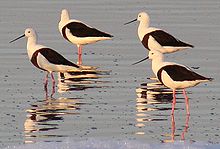Banded stilt
| Banded stilt | |
|---|---|

| |
| Banded Stilts, Governors Lake, Rottnest Island | |
| Scientific classification | |
| Kingdom: | |
| Phylum: | |
| Class: | |
| Order: | |
| Family: | |
| Genus: | Cladorhynchus Gray,GR, 1840
|
| Species: | C. leucocephalus
|
| Binomial name | |
| Cladorhynchus leucocephalus | |
The banded stilt (Cladorhynchus leucocephalus) is a stilt bird from Australia. It is a type of water bird known as a wader.
The bird gets its name from the red-brown stripe that adults have on their chests. Younger birds do not have them. Its other feathers are pied (black and white) and the eyes are dark brown. The Banded stilt is 35–45 cm tall.[2] It is called the "Flamingo of Australia",[3] and the Rottnest snipe on Rottnest Island. However, it is not related to true snipes.
They spend much of their life looking for food near the ocean in river estuaries and on tidal flats, but they lay eggs in the desert when it rains there.[3] They lay 1-5 eggs at a time. The eggs are white, brown or black eggs. The nests are small holes scraped in the sand or sandy clay. Banded stilts breed on islands created when dry salt lakes fill with water.[4][5] They come to the lakes to eat the brine shrimp, Paratemia.[3] The eggs of the shrimp can lie in the dry lake beds for many years until the rains fall.
In 200 years of Europen settlement in Australia, people have only recorded banded stilts laying eggs on 20 occasions.[3] In South Australia, where the stilts are listed as a vulnerable species,[6] they have only bred seven times in the last 70 years.[6] In 2010 there was a huge breeding event at Lake Torrens National Park where more than 150,000 birds gathered as the lake filled for only the second time in 150 years.[4] The eggs and chicks are often eaten by silver gulls. In 2000 when the stilts were breeding on Lake Eyre, nearly all the chicks were eaten.[4]

References[change | change source]
- ↑ "Cladorhynchus leucocephalus (Banded Stilt)". iucnredlist.org. 2011. Retrieved 22 May 2011.[permanent dead link]
- ↑ Morcombe, Michael (2003). Field Guide to Australian Birds. Archerfield, Queensland: Steve Parrish Publishing. p. 128. ISBN 174021417X.
- ↑ 3.0 3.1 3.2 3.3 "Natural History Programs– ABC Nature". abc.net.au. 2011. Retrieved 22 May 2011.
- ↑ 4.0 4.1 4.2 Elder, John (11 July 2010). "Rain's blessing: stilt chicks take their first steps". theage.com.au. Retrieved 22 May 2011.
- ↑ "Banded Stilt". Australian Museum. Retrieved September 9, 2021.
- ↑ 6.0 6.1 "Banded stilts breeding at Lake Eyre". shorebirds.org.au. 4 June 2010. Archived from the original on 19 February 2011. Retrieved 22 May 2011.
- Marchant, S.; & Higgins, P.J. (Eds). (1993). Handbook of Australian, New Zealand and Antarctic Birds, Volume 2: Raptors to Lapwings. Oxford University Press: Melbourne. ISBN 0-19-553069-1

